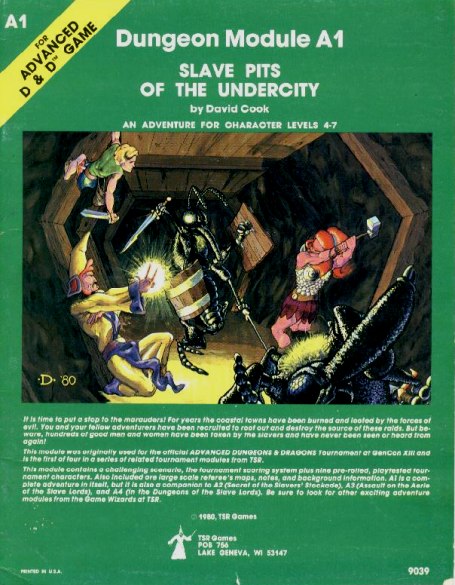Slave Pits of the Undercity
 Classic D&D adventure module review
Classic D&D adventure module review
Slave Pits of the Undercity, by David Cook – Advanced D&D, 1980
An adventure for character levels 4-7
24 pages plus the separate cover with maps on the inside faces. The adventure has over 40 numbered areas on two dungeon levels, and there are two new monsters: the aspis (humanoid insects) and the giant sundew (monster plant).
This module was originally written as a tournament adventure, and there are several pages of information on running it as a tournament adventure, including 2 pages for the tournament Player Characters, a page on tournament scoring, and 2 pages for the tournament versions of the maps. There are also notes in the first pages and throughout the main text on how to handle the encounters in a tournament game. Its origin as a tournament adventure is the biggest problem with this module.
The concept for the module works fine as a general campaign adventure, but there was no rewriting to make the overall setting work in a logical way for campaign play. The author added more rooms and encounters, between and around the limited tournament encounter areas, but they don’t work together in any logical way.
The adventure setting is a ruined temple being used as a slave depot in the middle of a monster-controlled city. The biggest omission is any information on the city itself. All the text gives a DM is:
Highport was once a human city, but the land and town have been overrun by humanoids — orcs, goblins, kobolds, ogres, and gnolls. Looted, burned, and ill-kept, the city has become a base for human outcasts wishing to deal with these unsavory creatures.
This description does serve to stir the imagination, but really, this setting needs more than just two sentences. This city sounds like a whole campaign setting for adventure, but the text only offers it as a vague backdrop for the dungeon adventure.
But even the dungeon setting, itself, is given only a vague description, with the maps showing only part of the ruined temple. The maps, and the room and encounter text, only show and describe the main temple proper and the underground passages around part of the city’s sewer system. The maps and text suggest much more beyond what is shown and explained, but it is up to the DM to figure out and detail.
Most tournament modules were designed for a party to just be at the first encounter area and to work their way through the dungeon in a set time limit, and this is acceptable for a tournament game. But for campaign play, most Player Character parties don’t just magically appear in front of the dungeon, and they don’t complete the whole thing in one day of adventure. Campaign parties have to get to the location, and probably will have to pull out of the dungeon to rest and recuperate at least once during the adventure. This module gives no information or guidance on the greater setting of the dungeon. This gives details on just two parts of a larger location in the middle of a monster city. It’s like the module author said, “Here’s two levels of a bigger location set in the middle of a monster town. You can create the rest of the location and the town.”
The dungeon levels and rooms and encounters just fail in overall unity. Some of the individual areas and encounters are quite interesting and challenging, but when looked at as parts of the greater whole they are supposed to be, they have no logic or sense. The overall structure is supposed to be a slaver fort, where slave buyers come to look at and purchase slaves. But when you look at the layout, you see that there are no safe routes through the fortress. There are monsters and traps everywhere, such that it is impossible for the inhabitants (guard patrols, slave chain gangs, and legitimate [evil] visitors) to actually get around the place.
Wild ghouls, wights, and even basilisks wander the same halls (as wandering monsters) as orc guards and slavers. (There’s a 4th-level cleric and a 6th-level cleric in the fortress, but there’s no information or indication that they control the undead.)
Ruin Encounter Table (roll d6)
Encounter occurs 1 in 6 (d6), check each turn.
1.-2. Orcs (special); see below
3. 1-2 Basilisks
4. 2-8 Ghouls
5. Wight
6. Slavers (special); see below
And then some of the area encounters, though interestingly set up, make no sense as a part of the overall fortress. Taken as separate, set piece challenges, some of the encounters are fun and clever, but they just boggle the mind when you consider them in total.
I’m sure that tournament players don’t have time or the inclination to think about the fortress as a whole, because they are just playing to see how far they can get through the challenges faster than other teams. But in a normal game, campaign experience, players will notice the stupidity of having encounters grouped in illogical ways.
I ran this adventure twice, a few years apart, and both times, with different groups, the players started noticing the wonkiness of the dungeon setting. They started asking questions of the fortress denizens, and since the module text gives no help in this regard, I was at a loss to have the NPCs answer the questions. I mean, questions to orc guards as simple as, “How did you get into this room?” and “How do we get to the slave pens?” left me looking at the map and text with a dumb look on my face.
As a whole, this adventure module is bad. The various room encounters read like they were written by different people with no concept of what the next room was, or what the overall environment was. A pure hack-and-slash group of players, who don’t think of the adventure beyond the room they are currently attacking may not cause any problems for a DM. But a group of players who put any thought into their infiltration plans, or try to conceptualize the overall layout of the fortress, or try to question the denizens of the place will cause a DM a bunch of headaches.
You could probably mine this module for cool individual encounters to pull out and drop into other adventures, but don’t try to run this as a logical, unified setting. It’s like a bunch of random room encounters thrown together and connected with five-feet-wide corridors.
Bullgrit






 Categories:
Categories: 







